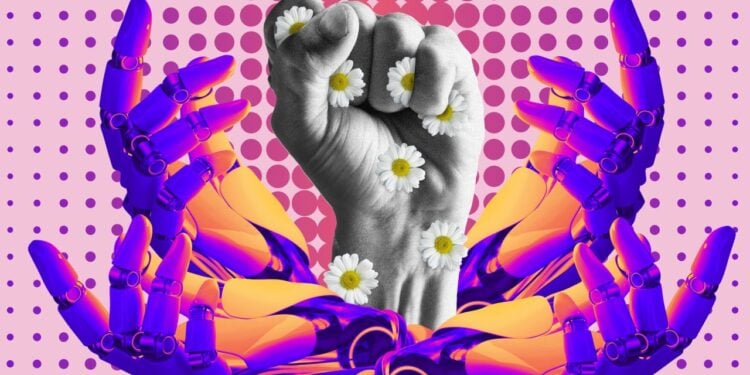- The results DALL-E 2 has been showing are promising and worrying in their efficiency. Tech moguls whose primary goal is automation development are not worried, but graphic designers — who may see DALL-E 2 as threatening — are.
- Luckily, DALL-E 2’s implications will be far less harmful to professionals than it may seem.
- Instead of taking graphic designer jobs away, it will augment them and help small businesses and coworking spaces that may not be able to afford graphic designers to brand their company optimally.
The name DALL-E probably brings to mind the image of the beloved Pixar robot, WALL-E, but in reality, the photos DALL-E can bring to life are next to infinite.
The capabilities of DALL-E from OpenAI in producing images out of text descriptions are impressive, from looking at OpenAI’s online gallery display.
Using natural language algorithms, DALL-E can draw multiple three-dimensional objects. In addition, its internal and external structures can understand context and inferences and generate images in various photo-realistic styles.
DALL-E can even combine completely unrelated things into a single coherent image. But what is arguably most impressive about this is that its understanding of our commands prompts these images through text.
If you want an image of a capybara looking off into the sunset, which is in the distance in the style of a surrealist painting, DALL-E has you covered for this and any other image you can think of.
DALL-E 2 will be able to apply each of these capabilities to existing images and with much higher-quality outcomes, making for compelling and streamlined appearance creating and editing software.
The level of detail DALL-E 2 can create is unprecedented. Users can think of any time, place, or context and the set of features or attributes they wish to apply to an image of it, write it out, and DALL-E 2 will quickly provide them with the idea.
What threat is DALL-E 2 to graphic design?
Given DALL-E 2’s capacities, many in the graphic design world are worried about their career prospects and whether they will need to find a new path.
“Although I firmly believe AI will create lots of new jobs and make many existing jobs much better by doing the boring bits well, I think it’s important, to be honest, that it’s increasingly going to do some jobs not very relevant (like technology frequently does),” said Sam Altman, CEO OpenAI.
As a broad statement about the automation of tasks, Altman is right. Technological advancement does not possess a law-like lopsidedness towards taking away jobs historically, but instead always creates new jobs and outdates old ones.
And Altman is confident that DALL-E 2 is a creativity-enhancing technology, not a creativity-diminishing one, and will enhance the experience of working in media and communications.
There is no doubt about that. Visual artists can appreciate a draft of an image they want to design and an editor they do not need to hire on Upwork.
Graphic design as a craft will be revolutionized by DALL-E 2 if OpenAI’s demo presentations genuinely represent the final product, but that doesn’t glean much on the future of working for graphic designers. Job security is a whole separate matter than a craft’s success.
Graphic design will change, but it is not going anywhere
C.J. Yeh, a professor at FIT’s Communication Design Foundation, believes that AI like DALL-E 2 will not destroy the graphic design field as a whole, but that it will eliminate a great deal of lower-level graphic design roles that entail quick turnaround times and which require little visual complexity.
DALL-E 2 has significant drawbacks that show that OpenAI’s demo is not wholly representative of DALL-E 2 when put into practice.
For instance, DALL-E 2 has trouble creating more than one detailed face in a single image, can only do well with generic foregrounds and backgrounds, cannot render novel (i.e., unlearned) objects, and does not understand the non-standard usages of words.
AI’s inability to process non-natural language — i.e., indirect meanings and implicatures — prevents it from understanding and synthetically replicating most human creativity, namely novelty, or the ability to create infinite original things out of a limited set of things.
DALL-E operates on a limited set of natural language symbols and their meanings, from which it can generate only a finite number of original things. Humans, on the other hand, thrive in developing the novel and AI is a long way away from that distinctly human capacity.
This does not mean, however, that no graphic designers will lose jobs. On the contrary, the much graphic design work comes from low-paying content mills, from which the results are expected to have been done quickly and imperfectly for a low price.
This is why small businesses and coworking spaces so often utilize project marketplace sites for their content needs: branding is essential for business success, and having a low startup cost for such an important business element can massively help with proper budgeting.
These simplistic design jobs will be the first to go, making DALL-E a cheap and viable option for coworking spaces and small businesses.
For the bulk of graphic designers who are not working on simplistic, limited-scope projects, there is no need to fear that AI will automate graphic design or another creative field; it will only enhance it for the foreseeable future.


 Dr. Gleb Tsipursky – The Office Whisperer
Dr. Gleb Tsipursky – The Office Whisperer Nirit Cohen – WorkFutures
Nirit Cohen – WorkFutures Angela Howard – Culture Expert
Angela Howard – Culture Expert Drew Jones – Design & Innovation
Drew Jones – Design & Innovation Jonathan Price – CRE & Flex Expert
Jonathan Price – CRE & Flex Expert












